
Selecting the right trailer for your ATV is crucial to maximizing your outdoor adventures. Whether you’re planning a weekend getaway or just a day at the trails, having the appropriate gear is essential for ensuring that your ATV is transported safely and securely. With various options available in the market, knowing what to look for can make all the difference.
First and foremost, consider the size and weight of your ATV. This will directly impact the type of trailer you need. A trailer must have the capacity to support the weight of your gear while also providing enough space for any additional accessories or equipment you may want to take along. Understanding your ATV’s specifications will help narrow down your choices significantly.
Another critical factor is the transport features of the trailer. Look for a model that offers ease of loading and unloading, as well as stability during travel. Features like ramps, tie-down points, and a low profile can enhance your experience by making the process smoother and safer. Prioritizing functionality will ensure that your ATV is not only adequately supported but also accessible when you reach your destination.
Determining the Right Size and Weight Capacity for Your Trailer

When selecting an ATV trailer, the appropriate size and weight capacity are essential for ensuring safe and efficient transport of your gear. Here’s how to determine what you need:
- Assess Your ATV Size:
Start by measuring the dimensions of your ATV. Ensure that the trailer can accommodate the length, width, and height of your machine. It’s crucial to allow additional space for securing gear and accessories.
- Consider Your Cargo:
Next, evaluate the type and amount of gear you plan to transport. This may include tools, camping equipment, or recreational items. Calculate the total weight of these items to determine the trailer’s weight capacity requirements.
- Check Manufacturer Specifications:
Review the manufacturer’s guidelines for both your ATV and the trailer. Each trailer will have a specified weight limit that should not be exceeded to avoid damage and ensure safety during transport.
- Evaluate Load Distribution:
Proper load distribution is vital for a stable ride. Keep heavier items positioned low and centered on the trailer to maintain balance. This will also help the trailer handle better while towing.
By focusing on these factors, you can choose an ATV trailer that meets your size and weight capacity needs, ensuring successful outings with your gear.
Choosing the Best Material and Build Quality for Durability
When selecting an ATV trailer, the material and build quality are crucial factors that directly impact its durability and longevity. For optimal performance, look for trailers constructed from high-quality materials such as steel or aluminum. Steel trailers tend to be stronger and more resistant to heavy loads, making them ideal for transporting larger ATVs. However, they can be heavier and prone to rust if not properly coated. Aluminum trailers are lighter, resistant to corrosion, and generally easier to maneuver, but they may not offer the same load capacity as steel options.
In addition to material, the build quality of the trailer plays a significant role in its overall durability. Look for features such as reinforced welding, a sturdy frame, and a reliable axle system. These components contribute to the trailer’s ability to withstand harsh conditions and the rigors of transport. The weight distribution and balance of the trailer are also important; a well-engineered design will provide stability during transport, reducing wear and tear on both the trailer and the ATV.
Consider the environmental conditions in which you’ll be using the trailer. If you plan on frequently transporting your ATV in wet or muddy conditions, a trailer with a galvanization or powder-coating finish will help prevent corrosion and extend its lifespan. Additionally, inspect the trailer’s components, such as the tires and brakes, for quality assurance, as these will affect not only durability but also safety during transport.
Ultimately, investing in a trailer made from superior materials and built with high standards will ensure durability, allowing you to transport your ATV confidently for years to come.
Understanding Trailer Features for Easy Loading and Transporting Gear

Selecting the right trailer involves understanding various features that facilitate both loading and transporting your gear effectively. One of the primary considerations is the ramp design. A trailer with a wide, sturdy ramp allows for easier loading of ATVs and other equipment, minimizing the risk of accidents and damage during the process.
Another crucial feature is the weight capacity of the trailer. You need to ensure that it can safely support the total weight of your gear. Overloading a trailer can lead to poor handling, increased wear on tires, and potential safety hazards on the road.
Adjustable tie-down points are also essential. These allow you to secure your gear properly, preventing movement during transport. Look for trailers that offer multiple anchor points for versatility in securing different types of equipment.
Additionally, consider a trailer with a low deck height. A lower profile makes loading and unloading more manageable, especially for heavier gear. It also contributes to stability while towing, enhancing safety on the road.
Another feature to look for is the inclusion of side rails or a fence around the trailer. This provides added safety for loose items, ensuring that nothing will fall out during transport. It also allows for quick access to your gear without having to unstrap everything completely.
Lastly, built-in storage compartments can be beneficial. These extra spaces help organize tools and smaller gear, keeping everything accessible and reducing clutter during your trips.
 Skip to the content
Skip to the content 